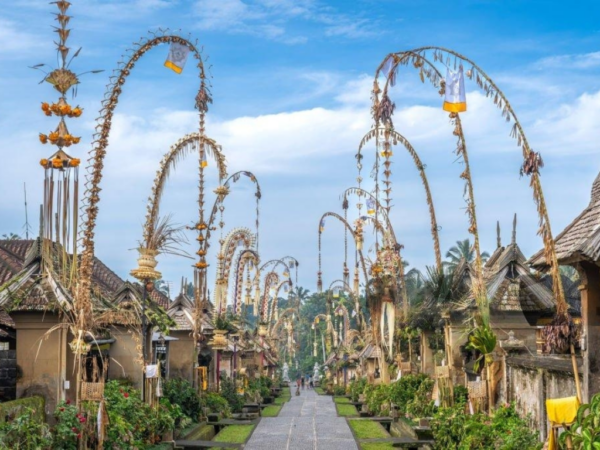
Galungan is one of the most significant religious holidays celebrated by Balinese Hindus in Indonesia. It marks the moment when the forces of good, symbolized by Dharma, triumph over the forces of evil, represented by Adharma. Occurring every 210 days, according to the Balinese Pawukon calendar, this festival holds deep cultural and spiritual meaning for the people of Bali. In this article, we’ll explore the history, traditions, and cultural significance of Galungan, while optimizing for search engines to help you learn more about this vibrant holiday.
What is Galungan Day?
Galungan is often described as the moment when ancestral spirits visit the Earth. The Balinese people celebrate by expressing gratitude to the gods and their ancestors through prayers, rituals, and offerings. The holiday lasts for 10 days and culminates with Kuningan, a day that signifies the return of the ancestral spirits to heaven.
The festival symbolizes the victory of good over evil, encouraging the people to be mindful of their spiritual journeys and to seek balance in their lives. It also represents the return of harmony to the universe, reminding people to uphold moral values and practice kindness.
The History and Origins of Galungan
The origins of Galungan can be traced back to ancient Hindu teachings, specifically the battle between the Balinese gods and the evil king Mayadenawa. According to the legend, Mayadenawa’s malevolent reign brought suffering to the people of Bali, and the gods ultimately intervened to defeat him. This story of triumph has been passed down through generations, and Galungan serves as an annual reminder of the importance of righteousness and integrity.
Key Rituals and Traditions
- Penjor
One of the most recognizable aspects of Galungan is the use of Penjor—long, curved bamboo poles decorated with palm leaves, fruits, rice, and flowers. These poles are placed outside homes and temples as offerings to the gods. The Penjor is believed to bring prosperity and happiness, symbolizing Mount Agung, the sacred mountain in Bali. - Offering Ceremonies
Offerings, known as Banten, are a central part of Galungan. Families prepare intricate offerings made of flowers, fruits, and cakes to present to the gods and ancestral spirits. These offerings are placed in temples, homes, and on the Penjor as a sign of gratitude and devotion. - Temple Visits
During Galungan, Balinese Hindus visit temples to offer prayers and participate in ceremonies. Traditional attire is worn, and entire families come together to show their respect to the gods and ancestors. It’s common to see people carrying their offerings on trays as they head to the temple. - Ngelawang
A unique tradition during Galungan is Ngelawang, a ritual performed to ward off evil spirits. Barong, the mythical lion-like creature, visits villages and homes to perform dances that protect people from harm. Ngelawang is especially popular among children, who follow the Barong around the village as it dances.
When is Galungan Celebrated?
Galungan follows the Pawukon calendar, so its dates vary each year. However, it generally occurs every 210 days. As Galungan is a recurring festival, it provides an opportunity for visitors to experience Bali’s rich cultural heritage, no matter when they visit.
What to Expect if You’re Visiting Bali During Galungan
If you’re visiting Bali during Galungan, expect to see vibrant decorations, festive processions, and temple ceremonies. The island transforms into a lively spiritual hub, and many tourist spots may be more crowded than usual. While some businesses might close for the holiday, most tourist-related services remain open.
Participating in the festivities is a wonderful way to immerse yourself in Balinese culture. You can observe the making of Penjor, participate in offering ceremonies, or even visit temples to witness the prayers and rituals. Be mindful, though, to dress appropriately and show respect for the local customs and traditions.
Cultural Significance of Galungan
For the Balinese people, Galungan represents more than just a holiday—it is a reflection of their deep connection to their faith and ancestors. The festival serves as a reminder to lead a virtuous life, aligned with the principles of Dharma. By upholding moral values and practicing mindfulness, the Balinese believe they can maintain balance in the world and ensure the prosperity of future generations.
Conclusion
Galungan Day is a profound celebration of good prevailing over evil and a time for the Balinese people to honor their ancestors and the gods. The festival is rich in tradition, with rituals that involve offerings, prayers, and community gatherings. Whether you’re a traveler seeking to experience Balinese culture or someone curious about this sacred festival, Galungan provides a unique window into the island’s spiritual life.






